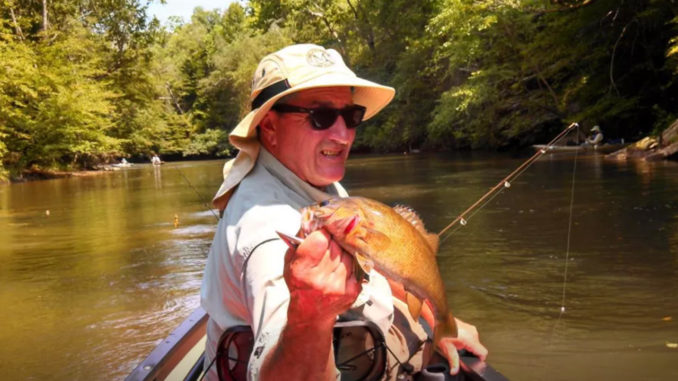
Dan, New and Yadkin all offer great fishing
The river water was clear and flowing smoothly. The paddle downstream was easy. The sandy bottom, highlighted with dark rocks, provided the perfect backdrop to spot the silhouettes of the fish swimming in the breaks.
My plastic crawfish lure was too much for the bass to resist. The fish hit the bait with the ferocity of a warrior, bending the rod double and taking line with a familiar high-pitched singing of the drag on the reel. Most fishermen would expect a largemouth weighing 6 to 8 pounds. Instead, the bass was only a little over 3 pounds.
Fishermen realize that the smallmouth, a smaller cousin of the largemouth, is one of the best-fighting freshwater fish around. North Carolina’s rivers from the western piedmont and throughout the mountains provide an abundance of these fierce fighters.
Gary “Froggy” Ribet, owner of Froggy Waters Outfitters in Danbury, targets three rivers when taking his clients out for lasting memories. One is the Dan which runs through his home territory.
While the Dan River has been in the news lately for the Duke Energy coal-ash spill, the territory he fishes is clean, clear water about 50 miles upstream. The river offers beautiful vistas, low pressure and even shuttle service so paddlers can fish at their own pace while drifting downriver. The river fishes best when clear or slightly stained, but like most bass-fishing conditions, when the water is muddy the fish become very finicky.
The New River in Northwest North Carolina between West Jefferson and Sparta is another prime smallmouth paddling destination. Even when it rains, Ribet (919-201-7882) said the river will usually clear within 24 to 36 hours. The fish are more abundant than in the Dan, however, the fishing pressure is greater as well.
“Each hole on the New fishes exactly the same. Basically, when you set up on a system, it works the rest of the day, barring no extenuating circumstances from Mother Nature,” Ribet said.
If you are looking for that trophy smallmouth that reaches North Carolina Angler Recognition Program citation minimums of 3 pounds or 19 inches long, the Yadkin River may very well offer the best chance. Timing is everything on the Yadkin, as the river can remain dark and stained even in times of drought, but when the fish are on, they are aggressive. There are available shuttle services for paddlers as well.
In all three rivers, the key to finding the fish is to search for boulders and large rocks that break the current. You can locate slower water by looking for sand in pools. Slower water allows the sand to drop to the bottom. This is where the fish will be hunting.
Getting to the fish is just part of the equation to a successful smallmouth fishing trip. The other part is getting them to bite. Ribet likes to use soft plastics in late summer and early fall.
“I switch from spinnerbaits and buzzbaits to much slower patterns such as jigs, tubes and my favorite, a Senko,” said Ribet, who really tries to put together a pattern the fish are using, starting with places, then keying in on the lures and colors. Once that’s established, start playing with size of the lure, keeping the pattern intact.
“You will find the pattern matches, but the size can increase, to a point,” Ribet said. “Sometimes they just want a smaller bait, and as the water temperature drops, you just have to slow down.”
Ribet and his guides know the rivers well and regularly catch from 10 to 30 or more fish on a trip. One of Froggy Waters’ five full-time guides, Brandon Jessup recently won the North Carolina Kayak Fishing Association’s smallmouth tournament.
While each of the rivers can be paddled and fished without a guide, one trip with knowledgeable anglers can teach you enough to make a future unguided trip even more memorable and enjoyable.



Be the first to comment